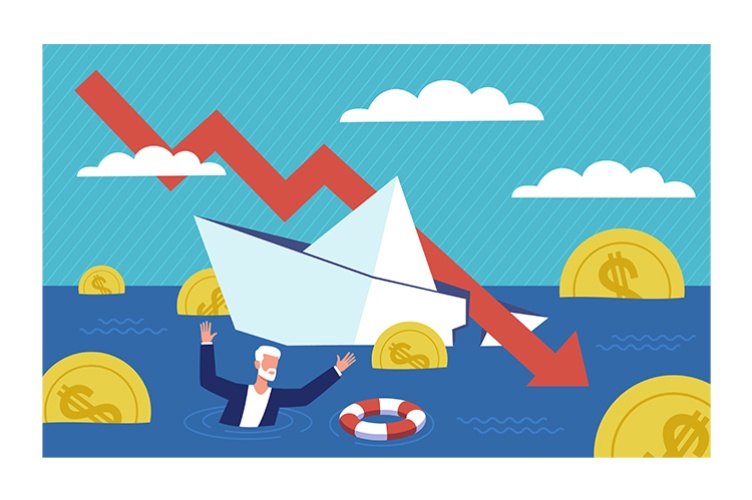Research Highlight Bank risk after bailouts: why CEO turnover matters
Are the CEOs of banks that had to be bailed out during the financial crisis more likely to retain their position or to be fired for taking their banks down risky paths? While the two issues might seem unrelated at first glance, Pramuan Bunkanwanicha, Alberta Di Giuli and their co-author demonstrated the link between bank bailouts and CEO turnover and its far-reaching implications for both the banks' individual risk profiles and systemic risk.
The worst of its kind since the Great Depression, the 2008 financial crisis wiped out millions of jobs and sent shockwaves through the global economy. To avoid a collapse of the entire system, governments in the US and Europe bailed out large financial institutions with loans worth billions (that's when households became familiar with the expression “too big to fail”).
But did the banks that were indeed rescued (at the taxpayers’ expense) learn a lesson, so to speak, and become more cautious? Or, because they were not forced to bear the brunt of the massive cost of their risk-taking behaviour, was their appetite for risk still as strong afterwards? This question – known in economic terms as a ‘moral hazard’ problem – is crucial, because it has repercussions for the stability of the entire system. A trio of researchers stressed this in a recent article. “Understanding individual banks’ risk-taking and systemic risk of the financial sector in general as well as their link to government bailouts in particular, are matters of utmost importance to scholars and regulators,” wrote ESCP Business School professors Pramuan Bunkanwanicha and Alberta Di Giuli with their co-author from the Paris School of Business: Federica Salvade. “However, little is known about whether and how public intervention affects banks’ risk appetite and contribution to systemic risk through bank CEOs’ turnover.”
The bank CEO in times of crisis: a captain in a storm or a liability?
Why did the authors examine the question through the angle of CEO turnover? “To the extent that CEO characteristics play a crucial role in corporate decision-making (Bertrand and Schoar, 2003) and affect the exposure of firms to systematic risk (Schoar et al., 2022), the replacement of bank CEOs following bailouts should have an impact on the risk profile of their banks,” they theorized. But are they indeed replaced after sending their company into a tailspin? Previous research does show that poor performance and especially bankruptcy has a personal cost for CEOs, but gives mixed evidence regarding lower-level employee careers.
So the researchers set out to specifically study bank CEO turnover during the 2008-2010 crisis and in its immediate aftermath (2011-2013). For their analysis, they used a “natural” testing ground: the Troubled Asset Relief Program (TARP) for US financial institutions. One of the US government's largest interventions during the 2008-2009 crisis, it injected $250 billion into the country's banking system, to help troubled banks temporarily stabilise their balance sheets and maintain lending to the corporate sector. They considered all 453 US-listed banks at the time, all eligible for TARP funding; 211 received it and 242 did not.
Turning to the employment record of the CEOs, they found that during the crisis, “TARP CEOs” (at the helm of banks that were bailed out) were significantly more likely to remain in place than non-TARP CEOs. Why weren't the CEOs of troubled banks fired during the crisis? Were banks unwilling to “punish” their risk-taking bosses? The authors suggested various alternative explanations: “Banks might have been reluctant to change their 'captain during the storm', or might have struggled to hire a new CEO during a crisis, given the high risk of TARP banks and their capped remuneration.”
Why risk-taking CEOs aren't always fired: the role of political capital
Most importantly for the stability of the financial system, did management turnover after bailouts affect banks' risk? The analysed the individual risk profile of TARP banks (vs. non-TARP banks) in terms of beta, volatility of returns and loan loss provisions before and after TARP was granted. While previous literature had shown that TARP exacerbates moral hazard problems and risk-taking, they showed that this was the case only if the CEO was retained. Conversely, CEO turnover decreased risk. Crucially, this was the case not only at bank level but also at systemic level. “CEO change might thus mitigate the moral hazard concerns of bailouts with positive implications for the stability of the financial system,” concluded the researchers.
However, their research did not stop there. Given the impact of CEO turnover on bank risk-taking and systemic risk, they figured it was important to look at the effect of bailouts on CEO careers over the longer term. They tracked the employment of CEOs up til December 2013 and found that TARP CEOs were 15% less likely than non-TARP CEOs to remain in their jobs for the post-crisis period, and 13% less likely to be employed as executives. In other words, government bailout had two opposite effects on CEO turnover, one during the crisis and another after.
Our findings suggest that TARP CEOs are replaced when banks have exhausted their ‘political capital’ and therefore need to lower their risk profile by firing their CEOs.
So why would CEOs remain in place during the crisis and then drop out of favour afterwards? The researchers supposed that far from “punishing” risk-taking managers, shareholders might simply replace them if future bailouts of their banks seem less likely. To disentangle possible explanations, Associate Dean for Research Pramuan Bunkanwanicha and his co-authors drew from the literature on political connections and government support, which shows that the latter plays a key role in the granting of the former.
Empirically, they analysed the effect of performance, ability to repay funds and political connections at both the CEO level (measured via personal contributions to parties in 2009-2010 and 2011-2012) and at bank level (banks are classified as politically connected if they are headquartered in the district of one of the House members who served in the Capital Market and Financial Institutions Subcommittee).
Consistent with their prediction, they found that CEO and bank political connections increased the probability of CEO change by 35% and 23%, respectively. “Political connections might have rescued the banks during the crisis; however, once they have been exploited, banks and CEOs have exhausted their 'political capital' and the ability to receive future bailouts being reduced, the CEO is therefore replaced with a less risk-taking one,” they deduced.
AUTHORS
 Federica Salvade Associate Professor of finance at Paris School of Business
Federica Salvade Associate Professor of finance at Paris School of BusinessCampuses
